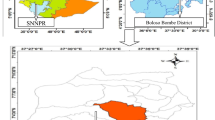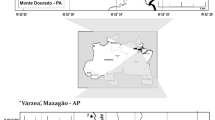Abstract
This paper reviews the floristic composition, vegetation structure, and diversity of three types of swamp forest that cover a considerable part of Guyana's North-West District. Trees, shrubs, lianas, herbs, and hemi-epiphytes were inventoried in three hectare plots: one in Mora forest, one in quackal swamp, and one in manicole swamp. The Mora forest, flooded annually by white water, was dominated by relatively few, large individuals of Mora excelsa. The very dense, thin-stemmed quackal forest, almost permanently flooded by black water, was characterized by Tabebuia insignis and Symphonia globulifera and contained few palms. The somewhat less dense manicole swamp, flooded regularly by brackish water, was distinguished by large numbers of Euterpe oleracea. Although the three swamps showed little overlap in floristic composition and densities of dominant species, they represent some of the lowest diversity forest in the Neotropics, with an α-diversity of 7.4 for the Mora forest, 8.2 for the quackal forest and 5.7 for the manicole swamp. When compared with similar vegetation types in the Guiana Shield, the swamp forests in this study show some interesting differences in species composition and density. The wetlands of the North-West District form the last stretch of natural coastline in Guyana and play an important role in the protection of riverine ecosystems. Furthermore, there is commercial potential for the extraction of non-timber forest products from these low-diversity forests. Nevertheless, in prolonged dry periods, large tracts of quackal forest are being burnt to give way to almost treeless, flooded savannas. For these reasons, adequate management and conservation strategies must be developed for the area.
Similar content being viewed by others
References
Alder D. and Synott T.J. 1992. Permanent sample plot techniques for mixed tropical forest. Tropical Forestry Papers 25. Oxford Forestry Institute. Dept. of Plant Sciences. University of Oxford.
van Andel T.R. 2000. Non-Timber Forest Products of the Northwest District of Guyana, Part I and II. Tropenbos-Guyana Series 8A and 8B. PhD Dissertation, Utrecht University, Wageningen.
van Andel T.R. 2001. Floristic composition and diversity of mixed primary and secondary forests in northwest Guyana. Biodiversity and Conservation 11: 1–38.
van Andel T.R., Van Huyskens P.E. and Bröker K.C.A. 1998. Palm heart harvesting in Guyana's Northwest District: exploitation and regeneration of Euterpe oleracea swamp forests. Tropenbos-Guyana Interim Report 98–1. Utrecht University.
Anderson A.B. 1988. Use and management of native forests dominated by açai palm (Euterpe oleracea Mart.) in the Amazon Estuary. In: Balick M.J. (ed.), The Palm-tree of Life: Biology, Utilisation and Conservation. Advances in Economic Botany 6. New York Botanical Garden, New York, pp. 144–154.
Anderson C.W. 1912. The forests of the North-West District of the country of Essequibo. Forests of British Guiana. Detail Reports Series 1. Department of Lands and Mines, Demerara, Georgetown.
Balée W. 1994. Footprints of the Forest: Ka'apor ethnobotany-The Historical Ecology of Plant Utilization by An Amazonian People. Colombia University Press, New York.
Cottam G. and Curtis J.T. 1956. The use of distance measures in phytosociological sampling. Ecology 47: 451–460.
Dallmeijer F., Kabel M. and Foster R.B. 1996. Floristic composition, diversity, mortality and recruitment of different substrates: a lowland tropical forest, Pakitza, Río Manu, Peru. In: Wilson D.E. and Sandoval A. (eds), Manu: The Biodiversity of Southeastern Peru. Smithsonian Institution, Washington, DC, USA, pp. 61–76.
Dallmeijer F. and Comiskey J.A. (eds) 1998. Forest Biodiversity in North, Central and South America, and the Caribbean. Research and Monitoring. MAB Digest. 21. UNESCO, Paris.
Davis T.A.W. 1929. Some observations on the forests of the North-West District. The Agricultural Journal of British Guiana 11: 157–167.
Davis T.A.W. and Richards P.W. 1934. The vegetation of Moraballi Creek, British Guiana: an ecological study of a limited area of tropical rain forest, Part II. Journal of Ecology 22: 106–155.
Ek R.C. 1997. Botanical diversity in the tropical rain forest of Guyana. Tropenbos-Guyana Series 4. Tropenbos-Guyana programme. PhD Dissertation, Utrecht University, Georgetown.
Ek R.C. and ter Steege H. 1998. The flora of the Mabura Hill area, Guyana. Botanisher Jahrbucher der Systematik 120: 461–502.
Fanshawe D.B. 1952. The vegetation of British Guiana. A preliminary review. Institute Paper No. 29. Imperial Forestry Institute, University of Oxford.
Fanshawe D.B. 1954. Forest types of British Guiana. Caribbean Forester 15: 73–111.
Fisher A.A., Corbet A.S. and Williams C.B. 1943. The relation between the number of species and the number of individuals in a random sample of an animal population. Journal of Animal Ecology 12: 42–58.
Forest Industries Development Survey (FIDS) 1970. Forest type map of the North-West District inventory area. Government of Guyana, United Nations Development Programme. Guyana Forest Department and Food and Agriculture Organisation of the United Nations.
Forte J. 1999. Karikuri: the evolving relationship of the Karinya people of Guyana to gold mining. New West Indian Guide 73: 59–82.
Gentry A.H. and Dodson C.H. 1987. Contribution of non-trees to species richness of a tropical rain forest. Biotropica 19: 149–156.
Goulding M., Lean Carvalho M. and Ferreira E.G. 1988. Rio Negro: Rich Life in Poor Water. SPB Academic Publishing, The Hague.
Hall P. and Bawa K. 1993. Methods to assess the impact of extraction of non-timber tropical forest products on plant populations. Economic Botany 47: 234–247.
Hammond D.S. and ter Steege H. 1998. Propensity for fire in Guianan rainforests. Conservation Biology 12: 944–947.
Henderson A. and Galeano G. 1996. Euterpe, Prestoea and Neonicholsonia (Palmae). Flora Neotropica, Monograph 72. New York Botanical Garden, New York.
Henderson P.A. and Robertson B.A. 1999. On structural complexity and fish diversity in an Amazonian floodplain. In: Padoch C., Márcia Ayres J., Pinedo-Vasquez M. and Henderson A. (eds), Várzea: Diversity, Development and Conservation of Amazonia's whitewater Floodplains. Advances in Economic Botany 13. New York Botanical Garden Press, New York, pp. 45–58.
Hiraoka M. 1999. Miriti (Mauritia flexuosa) palms and their uses and management among ribeirinhos of the Amazon Estuary. In: Padoch C., Márcia Ayres J., Pinedo-Vasquez M. and Henderson A. (eds), Várzea: Diversity, Development and Conservation of Amazonia's Whitewater Floodplains. Advances in Economic Botany 13. New York Botanical Garden Press, New York, pp. 169–186.
Hout P.van der 1999. Reduced impact logging in the tropical rain forest of Guyana: Ecological, economic and silvicultural consequences. Tropenbos-Guyana Series 6. PhD Dissertation, Utrecht University, Wageningen.
Huber O. 1995a. Vegetation. In: Steyermark J.A., Berry P.E. and Holst B.K. (eds), Flora of the Venezuelan Guayana. Vol. 1.Missouri Botanical Garden, St Louis, pp. 97–160.
Huber O. 1995b. Geography. In: Steyermark J.A., Berry P.E. and Holst B.K. (eds), Flora of the Venezuelan Guayana. Vol. 1.Missouri Botanical Garden, St Louis, pp. 1–61.
Huber O., Gharbarran G. and Funk V. 1995. Vegetation map of Guyana. Preliminary version. Centre for Study of Biological Diversity, University of Guyana, Georgetown.
Janssen J.J. 1974. Suriname's Amerindians. Who were they and where did they come from? In: Fontaine J. (ed.), From Suriname's History. Fragments of a Stirring Past. Suralco, de Walburg Pers, Paramaribo, pp. 10–20.
Johnston M. 1998. Tree population studies in low-diversity forests, Guyana. II. Assessment on the distribution and abundance of non-timber forest products. Biodiversity and Conservation 7: 73–86.
Johnston M. and Gillman M. 1995. Tree population studies in lowdiversity forests, Guyana. I. Floristic composition and stand structure. Biodiversity and Conservation 4: 339–362.
Kubitzki K. 1989. The ecogeographical differentiation of Amazonian inundated forests. Plant Systematics and Evolution 162: 285–304.
Lindeman J.C. 1953. The Vegetation of the Coastal Region of Suriname.Kemink en Zoon N.V., Utrecht.
Lindeman J.C. and Moolenaar S.P. 1959. Preliminary survey of the vegetation types of northern Suriname. In: de Hulster I.A. and Lanjouw J. (eds), The Vegetation of Suriname. Mededelingen van het Botanisch Museum en Herbarium van de Rijksuniversiteit te Utrecht 159, Utrecht.
Mennega E.A., Tammens-de Rooij W.C.M. and Jansen-Jacobs M.J. (eds) 1988. Checklist of Woody Plants of Guyana. Tropenbos Technical Series 2. The Tropenbos Foundation, Ede.
Padoch C. and Pinedo-Vasquez M. 1999. Farming above the flood in the várzea of Amapá: some preliminary results of the Projeto Várzea. In: Padoch C., Márcia Ayres J., Pinedo-Vasquez M. and Henderson A. (eds), Várzea: Diversity, Development and Conservation of Amazonia's Whitewater Floodplains. Advances in Economic Botany 13. New York Botanical Garden Press, New York, pp. 345–354.
Peters C.M., Balick M.J., Kahn F. and Anderson A.B. 1989. Oligarchic forests of economic plants in Amazonia: utilization and conservation of an important tropical resource. Conservation Biology 3: 341–349.
Philips O.L., Hall P., Gentry A.H., Sawyer A.S. and Vasquez R. 1994. Dynamics and species richness of tropical rain forests Proceedings of the National Academy of Sciences, USA 91: 2805–2809.
Polak A.M. 1992. Major Timber Trees of Guyana. A Field Guide. Tropenbos Series 2. The Tropenbos Foundation, Wageningen.
Prance G.T. 1979. Notes on the vegetation of Amazonia III. The terminology of Amazonian forest types subject to inundation. Brittonia 31: 26–38.
Ramdass I. 1990. A Definition of Priority Conservation Areas in Amazonia. Guyana Country Paper. Conservation International, Manaus.
Rosales Godoy J., Petts G. and Salo J. 1999. Riparian flooded forests of the Orinoco and Amazon basins: a comparative review. Biodiversity and Conservation 8: 551–586.
Salo J., Kalliola R., Häkkinen I., Mäkinen Y., Niemelä P., Puhakka M. et al. 1986. River dynamics and the diversity of Amazon lowland rainforest. Nature 322: 254–258.
Sarmiento G. 1983. Savannas of tropical America. In: Bourlière F. (ed.), Tropical Savannas. Ecosystems of the World 13. Elsevier Scientific Publishing Company, Amsterdam, pp. 267–269.
Schomburgk R.H. 1842. Expedition to the lower parts of the Barima and Guiana Rivers in British Guiana. Journal of the National Geographic Society 12: 169–196.
ter Steege H. 1990. A Monograph of Wallaba, Mora and Greenheart. Tropenbos Technical Series 5. The Tropenbos Foundation, Wageningen.
ter Steege H. 1993. Patterns in tropical rain forest in Guyana. Tropenbos Series 3. PhD Dissertation, Utrecht University, Wageningen.
ter Steege H. 1998. The use of forest inventory data for a National Protected Area Strategy in Guyana. Biodiversity and Conservation 7: 1457–1483.
ter Steege H., Lilwah R., Ek R.C., van der Hout P., Thomas R., van Essen J. et al. 2000. Composition and diversity of the rain forest in Central Guyana. Tropenbos-Guyana Reports 2000-1. Utrecht University, Utrecht.
Theunissen P.A. 1993. Vegetation and vegetation succession of the freshwater wetlands. In: Ouboter P.E. (ed.), Freshwater Ecosystems of Suriname. Kluwer Academic Publishers, Dordrecht, pp. 77–98.
Valkenburg J.L.C.H.van 1997. Non-timber Forest Products of East Kalimantan. Potentials for Sustainable Forest Use. Tropenbos Series 16. The Tropenbos Foundation, Wageningen.
Author information
Authors and Affiliations
Rights and permissions
About this article
Cite this article
van Andel, T. Floristic composition and diversity of three swamp forests in northwest Guyana. Plant Ecology 167, 293–317 (2003). https://doi.org/10.1023/A:1023935326706
Issue Date:
DOI: https://doi.org/10.1023/A:1023935326706




